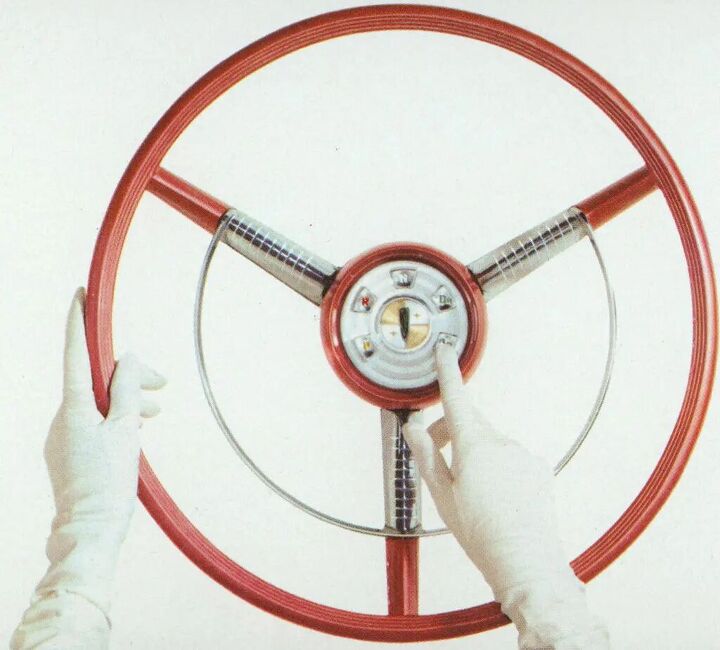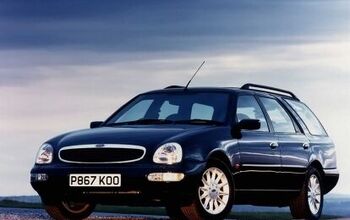Abandoned History: Ford's Cruise-O-Matic and the C Family of Automatic Transmissions (Part III)

We pick up our Cruise-O-Matic automatic transmission coverage again today, as Ford’s first mass-produced gearbox found its stride in the Fifties. As consumers turned toward automatic transmissions in their two- and four-door domestic iron, they also turned toward more powerful V8 engines and big chrome bumpers and tail fins. Detroit’s manufacturers had to respond, and Ford’s answer was a second-generation Ford-O-Matic, the FX and MX. Both transmissions were marketed under the new Cruise-O-Matic moniker, while a new generation two-speed auto became the bargain basement Ford-O-Matic.
As we discussed in our last entry, in 1957 and 1958 Ford offered fiddly Keyboard Control. The whiz-bang new feature meant the Cruise-O-Matic was operated by confusingly marked dash-mounted buttons on select Mercury vehicles. And while Keyboard Control was limited to Mercury, an even worse version of the same idea was reserved for Edsel.
Ford was determined from the early part of the Fifties that it could one-up General Motors with a new brand of car. The new brand would look different, have different features, and a unique model range all its own that was “independent” of Ford-Lincoln-Mercury. The end result of those ideas was Edsel, which we’ll cover separately in Abandoned History.
The new and crazy-looking Edsel cars debuted for the 1958 model year and offered a variation on the Keyboard Control idea on offer at Mercury. It was the wave of the future, and it was called Teletouch! While you might expect Ford simply ported the Keyboard Control onto Edsels, not so.
Keyboard Control used simple mechanical activation and was implemented in the dashboard of Mercury’s vehicles. Teletouch was a powered electro-mechanical system and was added to the center of Edsel’s steering wheels. So while the two systems requested the same actions of the Cruise-O-Matic transmission, they worked very differently.
Teletouch was part of Edsel’s attempt to market its way into relevance. The new button system was promoted as the future of the personal automobile, where the steering wheel became the central focus not only of driver attention but of the vehicle’s controls. Teletouch buttons were placed in the middle of the steering wheel; in theory, advantageous since they were in plain sight of the driver. Additionally, less of the dashboard was obscured when ye olde bulky gearshift selector was removed.
Contrary to the confusing labels of Keyboard Command, the Edsel Teletouch was straightforward: P, R, N, D, L, in that order. Drive was further explained as “Dr,” and Low was “Lo.” The button arrangement was immediately turned into a festive and creepy face mask for dealers to (presumably) wear and give to interested customers.
Edsel hyped Teletouch in its marketing and made it standard on the upmarket Corsair and Citation. The unsafe and ancient standard gear level remained an option for Edsel’s wagons, as well as the Pacer and Ranger.
Almost instantly, Teletouch ran into issues. Owners and the media thought it was distracting, and contrary to the natural motion they were used to with a column-mounted gear lever. Drivers were also used to horn functionality of the center of the steering wheel, and in emergency situations sometimes slammed the Teletouch with a hand or fist. Those events seldom led to the selection of a different gear but did sometimes damage the Teletouch button panel. In a win for the driver, the Teletouch pod was stationary and did not turn with the wheel.
Aside from the location and usage issues, the mechanical execution of Teletouch was also unsuccessful. The system required a servo motor to translate a driver’s instructions to the transmission. The motor was located between the Cruise-O-Matic’s bell housing and the exhaust and hung above the road. The motor was accompanied in that hot, dirty, and exposed location by wires and relays.
Unsurprisingly, the location of the Teletouch electronics meant transmission operation proved unreliable. All fault lay with the servo and its related components, as the stationary steering wheel buttons themselves were reliable. The buttons included an inhibitor switch for their activation that worked with fluid pressure, so a different gear could not be selected accidentally at speed. But it was not fool-proof: If Neutral was pressed first the hydraulic pressure was removed from the inhibitor switch, and Reverse or Park could then be selected. Such action leads to a broken parking pawl, a big crash, or both.
Like Edsel itself, Teletouch was not long for the world. It was used only in 1958, and in 1959 the feature was cut along with part of the Edsel lineup. And around the time Teletouch was about to become the scourge of Edsel, Russian automaker GAZ was in development of an automatic transmission for its new vehicles.
As we learned last time, Ford and GAZ had a formal relationship in the Twenties and Thirties. The first vehicles GAZ produced were licensed Fords. After that, the company took Ford’s Model A in a truck direction and then branched out into a lineup of its own cars. By the Fifties, the company was Russia’s premier automaker, with a lineup of off-road passenger cars, utilitarian trucks, and executive luxury cars for the communists who did not believe in being executive or luxurious – until they did.
In the Fifties, part of Russian luxury meant an automatic transmission. GAZ sought to add an automatic to the new GAZ-21 Volga midsize executive sedan (1956-1970) and to the GAZ-13 Chaika (1959-1981), the most luxurious car the company had ever produced. The Chaika (“seagull” in Russian) was a replacement for the first luxury car GAZ ever made, the American-looking GAZ-12 ZIM.
GAZ did a little investigation into automatic transmissions on offer at western automakers and decided the two-speed Ford-O-Matic and three-speed Cruise-O-Matic were the best. Then GAZ set about engineering their own copy and adding Russian spice to the existing Detroit flavor.
GAZ switched the Ford transmissions over to metric components so they’d be easier to manage. And both versions of the automatic received a new parking brake design that worked with a centrally-located drum between the bell housing and driveshaft. Ford’s parking brake grabbed the rear wheels. The GAZ setup meant a parking pawl was unnecessary and saved money.
For the lesser Volga, GAZ swapped the torque converter for an air-cooled version and then paired it to a 2.5-liter inline-four that was good for 65 horsepower. The Volga used a column shift, and drivers put it in H. Volga called its Ford-O-Matic take a three-speed, even though it operated in only two gears in Drive, like the actual Ford-O-Matic. The transmission was re-geared for Volga use.
The Volga automatic was not a hot seller and was discontinued within two years. The transmission was considered too difficult to maintain for the average driver, as few service stations could work on automatics and there was a general shortage of transmission oil. Less than 800 were made, and a conversion to manual transmission motivation was a common occurrence.
Cruise-O-Matic was the starting point for the luxurious Chaika limousine, and given the car used a 195-horse 5.5-liter V8 (of GAZ design) it required a bit less adaptation work than on the Volga. GAZ implemented a dashboard push-button shift like the Americans used at the time, and the Chaika even wore American styling. The transmission operated like a regular Cruise-O-Matic but was again geared to suit the Chaika’s smooth sailing requirements. GAZ left in a liquid cooling system for the transmission given all the power and torque.
The Chaika was available only with the GAZ-Cruise-O-Matic, and never built with a manual. There were not any proletariat maintenance concerns, as the Chaika was delivered only to state officials and never sold privately. With limited changes, the Chaika existed in its Fifties guise through 1981.
In the early Sixties, GAZ took the 5.5-liter and the three-speed Ford copy and put both into a midsize Volga. The creation was known as the GAZ-23, and the unassuming sleeper sedan was delivered in limited numbers to the KGB’s ninth directive. The 23 was mostly used as a speedy escort vehicle in personal security operations.
It’s a bit unclear just how long GAZ vehicles relied on the Cruise-O-Matic copy for their motivation, but it’s safe to assume it was at least through part of the Eighties, even outside the Chaika. We’ll return to domestic affairs next time, and discuss the Cruise-O-Matic’s transition into a C.
[Images: Ford, GAZ, YouTube]
Become a TTAC insider. Get the latest news, features, TTAC takes, and everything else that gets to the truth about cars first by subscribing to our newsletter.

Interested in lots of cars and their various historical contexts. Started writing articles for TTAC in late 2016, when my first posts were QOTDs. From there I started a few new series like Rare Rides, Buy/Drive/Burn, Abandoned History, and most recently Rare Rides Icons. Operating from a home base in Cincinnati, Ohio, a relative auto journalist dead zone. Many of my articles are prompted by something I'll see on social media that sparks my interest and causes me to research. Finding articles and information from the early days of the internet and beyond that covers the little details lost to time: trim packages, color and wheel choices, interior fabrics. Beyond those, I'm fascinated by automotive industry experiments, both failures and successes. Lately I've taken an interest in AI, and generating "what if" type images for car models long dead. Reincarnating a modern Toyota Paseo, Lincoln Mark IX, or Isuzu Trooper through a text prompt is fun. Fun to post them on Twitter too, and watch people overreact. To that end, the social media I use most is Twitter, @CoreyLewis86. I also contribute pieces for Forbes Wheels and Forbes Home.
More by Corey Lewis
Latest Car Reviews
Read moreLatest Product Reviews
Read moreRecent Comments
- 28-Cars-Later Ford reported it lost $132,000 for each of its 10,000 electric vehicles sold in the first quarter of 2024, according to CNN. The sales were down 20 percent from the first quarter of 2023 and would “drag down earnings for the company overall.”The losses include “hundreds of millions being spent on research and development of the next generation of EVs for Ford. Those investments are years away from paying off.” [if they ever are recouped, emphasis mine] Ford is the only major carmaker breaking out EV numbers by themselves. But other marques likely suffer similar losses. https://www.zerohedge.com/political/fords-120000-loss-vehicle-shows-california-ev-goals-are-impossible Given these facts, how did Tesla ever produce anything in volume let alone profit?
- AZFelix Let's forego all of this dilly-dallying with autonomous cars and cut right to the chase and the only real solution.
- Zelgadis Elantra NLine in Lava Orange. I will never buy a dirty dishwater car again. I need color in my life.
- Slavuta CX5 hands down. Only trunk space, where RAV4 is better.
- Kwik_Shift_Pro4X Oof 😣 for Tesla.https://www.naturalnews.com/2024-05-03-nhtsa-probes-tesla-recall-over-autopilot-concerns.html










































Comments
Join the conversation
With shifting being less mechanical and more electrical more manufacturers will eliminate the standard console shifter to save console space and to save costs. A dial is less expensive than a shifter. This is true with the parking brake that no longer is mechanical but electrical so the manufacturers eliminate the emergency brake pedal or the brake lever. Less moving parts and more chips. I miss the shift lever but I am getting use to the dial.
That shifter system was a pretty ambitious mechatronic design. But understandable why it didn't stay in production very long.